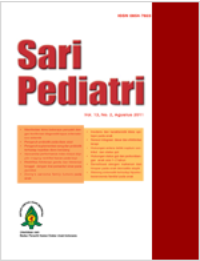Faktor Risiko yang Berperan pada Mortalitas Sepsis
Sari
Latar belakang. Sepsis merupakan penyebab utama kematian bayi dan anak. Status imun pejamu dan malnutrisi merupakan faktor penting yang menentukan luaran pada sepsis. Skor pediatric logistic organ dysfunction (PELOD) adalah sistem skoring disfungsi organ pada sakit kritis, untuk memprediksi mortalitas pasien sepsis.
Tujuan. Mengetahui faktor risiko usia, status gizi, dan skor PELOD terhadap mortalitas sepsis.
Metode. Retrospektif analitik berupa data rekam medis pasien berusia 1 bulan – 18 tahun di PICU RSCM bulan Apri1- Agustus 2011 dengan diagnosis sepsis menurut kriteria konsensus sepsis internasional.
Hasil. Sembilanpuluh dua dari 209 pasien mengalami sepsis, 22 (23,9%) di antaranya meninggal. Median usia subjek 15 (rentang 2-192) bulan dengan sebaran terbanyak pada kelompok usia 1 bulan – 1 tahun (62%). Sebagian besar subjek (57,61%) memiliki status gizi kurang. Fokus infeksi tersering adalah infeksi saraf pusat dan gastrointestinal, masing-masing 32 (34,77%) subjek. Gizi buruk (p<0,001; OR 26,88;IK95% 4,74-152,61) dan skor PELOD ≥20 (p<0,001; OR 78,8;IK95%14,23-436,36) merupakan faktor risiko yang secara independen berperan terhadap mortalitas sepsis pada anak.
Kesimpulan. Gizi buruk dan skor PELOD ≥20 berperan terhadap mortalitas sepsis pada anak. Usia <5 tahun tidak terbukti sebagai faktor risiko mortalitas sepsis pada anak.
Kata Kunci
Teks Lengkap:
PDFReferensi
Proulx F, Fayon M, Farrell CA, Lacroix J, Gauthier M. Epidemiologi of sepsis and multiple organ dysfunction syndrome in children. Chest 1996;109:1033-7.
Khan MR, Maheswari PK, Masood K, Qamar FN, Haque A. Epidemiology and outcome of sepsis in a tertiary care PICU of Pakistan. Indian J Pediatr 2012;12:34-40.
Shime N, Kawasaki T, Saito O, Akamine Y, Toda Y, Takeuchi M dkk. Incidence and risk factors for mortality in paediatric severe sepsis: results from the national paediatric intensive care registry in Japan. Intensive Care Med 2012;12:25-32.
Watson S, Carcillo JA, Linde-Zwirble WT, Clermont G,Lidicker J, Angus DC. The epidemiology of severe sepsis in children in the United States. Am J Respir Crit Care Med 2003;167:695-701.
Rekam Medis Departemen Ilmu Kesehatan Anak RSCM: data pasien di Unit Perawatan Intensif Pediatrik tahun 2009.
Balentine JR. Sepsis. [Diakses tanggal 5 Februari 2012]. Diunduh dari:http://www.emedicinehealth.com/sepsis_blood_infection/page8_em.htm.
Erdem G. Sepsis. [Diakses tanggal 5 Februari 2012]. Diunduh dari: http://www.hawaii.edu/medicine/pediatrics/pedtext/s06c16.html.
Martinot A, Leclerc F, Cremer R, Leteurtre S, Fourier C, Hue V. Sepsis in neonates and children: definitions, epidemiology, and outcome. Pediatr Emerg Care 1997;13:277-81.
Gogos CA, Lekkou A, Papageorgiou O, Siagris D, Skoutelis A, Bassaris HP. Clinical prognostic markers in patients with severe sepsis: a prospective analysis of 139 consecutive cases. J Infect 2003;47:300–6.
Wynn J, Cornell TT, Wong HR, Shanley TP, Wheeler DS. The host response to sepsis and developmental impact. Pediatrics 2010;125:1031-41.
Maat M, Buysse CM, Emonts M, Spanjaard L, Joosten KF, de Groot R, dkk. Improved survival of children with sepsis and purpura: effects of age, gender, and era. Crit Care 2007;11:1-10.
Markovitz BP, Goodman DM, Watson RS, Bertoch D, Zimmerman J. A retrospective cohort study of prognostic factors associated with outcome in pediatric severe sepsis: what is the role of steroids?Pediatr Crit Care Med 2005;6:270-4.
Villegas D, Echandia CA. Factors associated with mortality through sepsis syndrome in children 31 days to 14 years of age. Hospital Universitario Del Valle, Cali. [Diakses tanggal 4 Februari 2012]. Diunduh dari: http://colombiamedica.univalle.edu.co/index.php/comedica/article/viewArticle/727/1188.
Menezes FS, Leite HP, Nogueira PCK. Malnutrition as an independent predictor of clinical outcome in critically ill children. Nutrition 2012;28:267-70.
Briassoulis G, Zavras N, Hatzis T. Malnutrition, nutritional indices and early enteral feeding in critically ill children. Nutrition 2001;17:548-57.
Hulst J, Joosten K, Zimmermann L, Hop W, Van Buuren S, dkk. Malnutrition in critically ill children: from admission to 6 month after discharge. Clin Nutr 2004;23:223-32.
Corish CA, Kennedy NP. Protein-energy undernutrition in hospital inpatients. Br J Nutr 2000;83:575-91.
Correia MITD, Waitzberg DL. The impact of malnutrition on morbidity, mortality, length of hospital stay and cost evaluated through a multivariate model analysis. Clin Nutr 2003;22:235-9.
Metta D, Soebardja D, Soemasetia DH. The use of Pediatric Logistic Organ Dysfunction (PELOD) scoring system to determine the prognosis of patients in pediatric intensive care units. Pediatr Indones 2006;46:1-6.
Hendra, Runtunuwu AL, Manoppo JIC. Pediatric logistic organ dysfunction (PELOD) score as prognosis of multiple organ failure in sepsis. Paediatr Indones 2010;50:226-32.
Lacroix J, Cotting J. Severity of illness and organ dysfunction scoring in children. Pediatr Crit Care Med 2005; 6:126-34
Leclerc F, Leteurtre S, Duhamel A, Grandbastiaen B, Proulx F, Gauvin F, dkk. Cumulative influence of organ dysfunction and septic state on mortality of critically ill children. Am J Respir Crit Care Med 2005; 171:348-53.
Leteurtre S, Martinot A, Duhamel A, Proulx F, Grandbastien B, Cotting J, dkk. Validation of the pediatric logistic organ dysfunction score: prospective, observational, multicenter study. Lancet 2003;362:192-7.
Goldstein B, Giroir Brett, Randolph A, the Members of the International Consensus Conference on Pediatric Sepsis. International pediatric sepsis consensus conference: definitions for sepsis and organ dysfunction in pediatrics. Pediatr Crit Care Med 2005;6:2-8.
Schaible UE, Kaufmann SHE. Malnutrition and infection: Complex mechanisms and global impacts. J Pmed 2007;4:0806-12.
Leteurtre S, Martinot A, Duhamel A, Gauvin F, Grandbastien B, Nam TV, dkk. Development of pediatric multiple organ dysfunctions score: use of two strategies. Med Decis Making 1999; 19:399-410.
Enrione MA, Powell KR. Sepsis, septic shock, and systemic inflammatory response syndrome. Dalam: Kleigman RM, Behrman RE, Jenson HB, Stanton BF, penyunting. Nelson textbook of pediatrics. Edisi ke-18. Philadelphia: Elsevier Inc;2007. h.1094-9.
Chakravarty A, Chatterjee SK. Sepsis and neurology. JAPI 2003;51:385-90.
Han YY, Shanley TP. Multiple organ dysfunction syndrome. Dalam: Nichols DG, penyunting. Roger’s textbook of pediatric intensive care. Edisi ke-4. Philadelphia: Lippincott Williams & Wilkins;2008.h.283-7.
Leteurtre S, Martinot A, Duhamel A, Gauvin F, Grandbastien B, Nam TV, dkk. Development of pediatric multiple organ dysfunctions score: use of two strategies. Med Decis Making 1999; 19:399-410.
Honna L, Triratna S, Triwani, Theodorus. Use of pediatric logistic organ dysfunction (PELOD) in determining prognostic among pediatric intensive care unit patients. Paediatr Indones 2010;50:347-50.
DOI: http://dx.doi.org/10.14238/sp15.5.2014.281-8
Refbacks
- Saat ini tidak ada refbacks.
##submission.copyrightStatement##
##submission.license.cc.by-nc-sa4.footer##
Email: editorial [at] saripediatri.org


Sari Pediatri diterbitkan oleh Badan Penerbit Ikatan Dokter Anak Indonesia
Ciptaan disebarluaskan di bawah Lisensi Creative Commons Atribusi-NonKomersial-BerbagiSerupa 4.0 Internasional.




